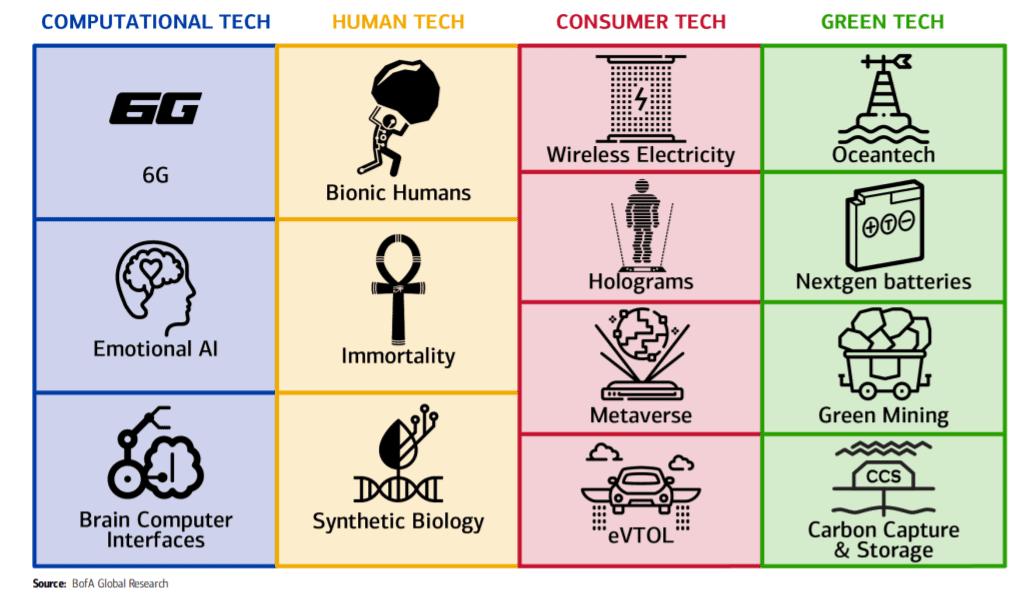What does the future of tech look like? What emerging technologies should we all be keeping an eye on? Bank of America Global Research recently published a 152-page research report identifying 14 “radical technologies that could change our lives and accelerate the impact of global megatrends.” These technologies have a $330B market size today that could grow to $6.4T by the 2030s, according to authors of the report.
“These moonshots could transform and disrupt multiple industries, contributing to the next big cycle of technology-driven growth,” says the BofA study. These are the 14 technologies they have their eyes on:
- 6G: “The next generation of telecom networks will be needed in less than a decade as data continues to grow exponentially and 5G reaches its upper limit capacity.”
- Brain Computer Interfaces: “As we reach a point where humans are unable to keep up with computers and AI, brain computer interfaces could help ‘level up’ humans with computers. Shorter term, brain computer interfaces hold solutions for paralyzed individuals and promise a new wave of innovation in gaming.”
- Emotional Artificial Intelligence: Also “known as ‘Affective Computing’ and ‘Cognitive Computing’ (it) is designed to capture, analyze and respond to human emotions and simulate human thoughts. EAI can potentially collect, analyze and respond to completely new varieties of data and situations and predict or simulate human thought, leading people to take action.”
- Synthetic Biology: “At its core, ‘synbio’, as the field is commonly referred to, takes advantage of the vast diversity of nature to make biomolecules that traditional chemistry cannot.”
- Immortality: “Traditionally, aging has not been viewed as a disease that can be treated but this is changing. Actors in this space are increasingly looking to tackle the hallmark of aging via pathways such as ‘genomic instability, telomere attrition, mitochondrial dysfunction, and cellular senescence’ among others.”
- Bionic humans: “This could be invasive (e.g. implants) or non-invasive (e.g. exoskeleton). Biohacking is also an associated field which is essentially applying DIY biology to boost oneself e.g. RFID chip in hand for contactless payments.”
- eVTOL: “Electrical vertical take-off and landing vehicles that could provide an alternative mobility transportation solution to outdated infrastructure and overly stressed roads in urban settings.”
- Wireless Electricity: “As the IoT takes off, automating and creating near continuous charging solutions could provide convenience for consumers, while solving charging problems for the rollout of EVs and secure electricity supplies for remote communities.”
- Holograms: “A technology capable of creating a simulated environment through light imagery projections that will allow everyone to come together in one virtual room, without having to leave their physical location.”
- Metaverse: A “future iteration of the Internet, made up of persistent, shared, 3D-shared spaces linked into a virtual universe. It could comprise countless persistent virtual worlds that interoperate with one another, as well as the physical world and transforming markets such as gaming, retail, entertainment etc.”
- Nextgen Batteries: “Whilst lithium batteries are the major EV technology, this does not necessarily need to stay true with alternatives such as solid state, vanadium flow, sodium ion etc provide promising additional attributes.”
- OceanTech: “It seeks to answer: ‘How do we increase sustainability of the ocean economy while harnessing its benefits?’ Solutions could include ocean energy, land-based aquaculture, and precision fishing using AI, etc.”
- Green Mining: “Transitioning away from a carbon-intensive economy will mean moving to a metal-intensive one. Green mining solutions like deep-sea mining, agromining, mining of wastewater and asteroid mining could provide less polluting and destructive solutions as the green economy’s thirst for metals grows.”
- Carbon Capture & Storage: “All current zero-carbon pathways require some form of CO2 removal. CCS, alongside other geoengineering solutions, could act as part of the solution with long-term permanent removal of CO2 vs afforestation.”

